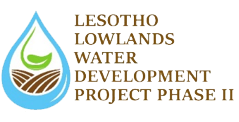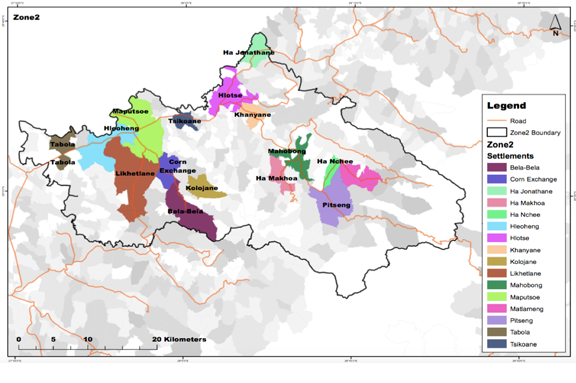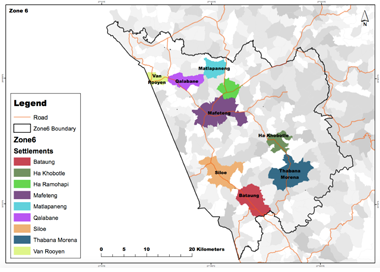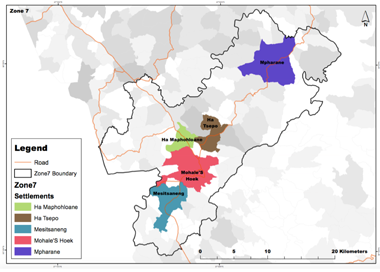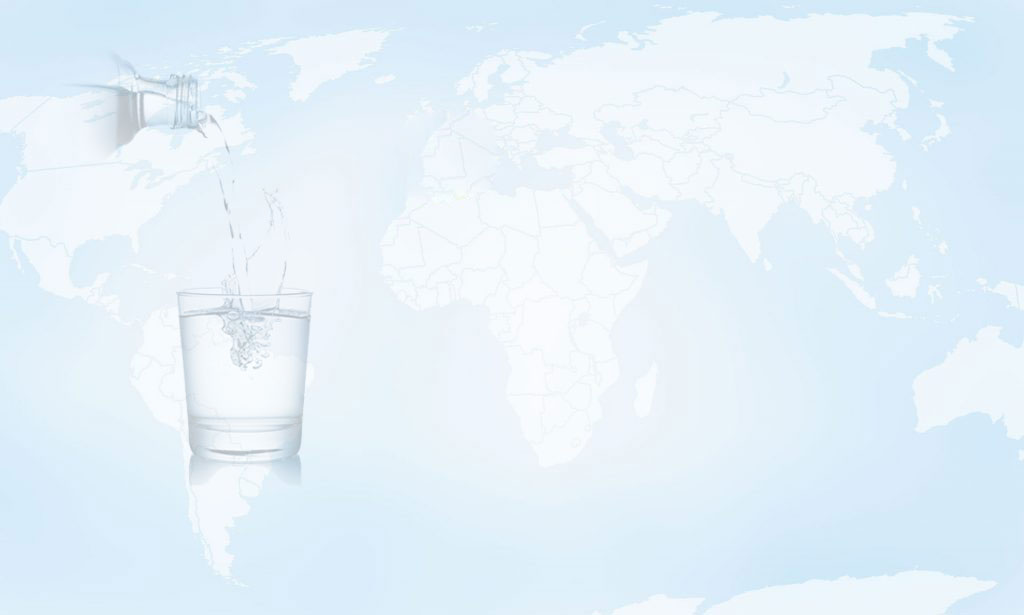

Lesotho Lowlands Water Development Project Phase II
The Lesotho Lowlands Water Development Project-Phase II (LLWDP-II) is designed and being implemented as a brain-child of the Lesotho Lowlands Water Supply Scheme. The LLWDP-II concerns itself with the two (2) prioritized packages, being the zones 2 & 3 package in the Hlotse-Maputsoe area, and the zones 6 & 7 package in the Mohale’s Hoek- Mafeteng area; respectively financed by the World Bank and the European Investment Bank in partnership with the European Union.
The LLWDP-II will construct bulk water infrastructure (intake structure, pump stations, raw water main, and water treatment plant, service reservoirs, transmission lines and booster pumps) in the prioritized areas, accompanied by improvements to the distribution systems and implementation of low-scale sanitation and hygiene measures to improve service delivery. It will also build capacity of service providers to reduce non-revenue water (NRW), improve billing and revenue collection, and strengthen overall planning and monitoring. In addition, it will provide technical assistance to support a long-term technical solution to ensure water security for domestic and industrial uses. Furthermore, the Project will support activities to strengthen water sector institutions’ ability to promote and operate in an efficient and effective manner.


Natural Water

Purity

Engineering

Continuity
Two Prioritised Areas by LLWDP II
Project Objectives
The proposed development objectives are to
i. Increase water availability and access to improved water supply services in two priority zones
ii. Improve the technical and financial performance of WASCO.
Project Components
- Water Supply Investments in Zones 2 & 3 and Zones 6 & 7
- Project Management and Institutional Capacity Building
- WASCO Performance Improvements
- Contingent Emergency Response Component (CERC)
This component will finance a program of activities designed to improve access to reliable domestic and industrial water supply services. The activities include:
i. Construction of the bulk water supply scheme which will abstract water from the Hlotse and Makhaleng Rivers respectively and transfer it to the intended beneficiaries. The system will include a river intake structure, source protection measures to protect the local environment and reduce the effects of flooding, a water treatment plant, transmission lines, reservoirs, and auxiliary facilities.
ii. Construction and rehabilitation of distribution water mains and networks in the Maputsoe and Hlotse towns, Mohale’s Hoek and Mafeteng towns and surrounding settlements, including installation of meters, household service connections, leakage reduction measures, and standpipes; and
iii. Consultancy services for construction supervision and quality assurance of water supply infrastructure contracts, technical studies, and engineering designs.
iv. Investments also include borehole rehabilitation in Maputsoe.
Implementation of these investments will be advanced into the first year of the project to deliver improved availability of water supply in response to the likely adverse impact of the “El Nino”
This component will strengthen sector institutions, support implementation of the LLWSS and develop a comprehensive Strategic Sanitation Plan through financing of consultancy services, systems, and equipment to support three broad categories of activities:
i. Project management, including support to the Project Implementation Unit (PIU); incremental operating costs; support for a panel of dam safety experts; support for safeguards (including any additional studies as needed) and preparation, implementation, and monitoring of site-specific environmental and social safeguards for the water distribution network; and support for project communications. Support to the PIU such as office rent and utilities, salaries for PIU support staff (project team assistants, drivers, etc.) will be covered under this component through counterpart funding. The Project Management Consultant will also be engaged to support the PIU in the implementation of the Project in order to ensure effective and efficient implementation of the Project
ii. Institutional strengthening support to other sector departments. This will include support to DRWS (operational and policy support), DWA (water quality monitoring), LBWSA (international experiences in bulk water supply agencies), CoW (miscellaneous studies and capacity building, including review of the tariff structure to assess, among others, the bulk water tariff), LEWA (technical data quality and auditing), and Ministry of Development Planning (MoDP) (improved oversight of project implementation)
iii. Strategic Sanitation Planning TA. This will support MoW to build upon existing policies and plans in the development of a medium-term sanitation program, based on updated sector diagnostics. The work will include preparation of master plans for selected urban locations, including but not limited to Maputsoe and Hlotse, Mafeteng and Mohale’s Hoek using the Citywide Inclusive Sanitation approach.
This component will support WASCO to improve its performance through a mix of institutional strengthening complemented by output-based payments with disbursement dependent on verifiable achievement of targets set in three Disbursement Linked Indicators (DLI). Loan proceeds will be on-granted to WASCO for the following activities
i. Institutional strengthening support to WASCO. The core of this activity comprises change management support to WASCO senior management and its Board of Directors to improve the culture and performance of the company. This is complemented by the DLIs which will incentivize WASCO to deliver measurable improvements in performance facilitated by the change management support. Further support includes resolving issues surrounding asset valuations, preparing detailed O&M plans for the project-financed infrastructure, and implementing annual customer satisfaction surveys.
ii. DLIs to incentivize WASCO to:
• improve the quality of their technical data and thus improve management decision making and the regulatory interface
• improve the quality of their financial data for improved management decision making, LEWA interface and for better statutory financial reporting; and
• deliver improved technical and financial performance against annual targets set by the regulator (LEWA).
In the event of an Eligible Crisis or Emergency, this contingent component will provide immediate and effective response to said Eligible Crisis or Emergency, defined as “an event that has caused, or is likely to imminently cause a major adverse economic and/or social impact associated with natural or man-made crises or disasters.”
The World Bank’s assistance may consist of immediate support in assessing the emergency’s impact and developing a recovery strategy or the restructuring of existing, or provision of new, Investment Project Financing. This may be particularly relevant with the possible adverse impacts of “El Nino” in the coming period. In all cases, the World Bank would adapt its rapid response in form and scope to the emergency’s particular circumstances and take into account the World Bank’s Country Partnership Strategy for the country.
